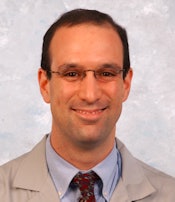
Radiologists love to complain about the challenges they face, including declining reimbursements, a tight job market, and increased workload. But there are at least six good reasons to be optimistic about the specialty, according to a presentation at the American Roentgen Ray Society (ARRS) annual meeting in Toronto.
It's all about one's point of view, said presenter Dr. Jonathan Berlin from the University of Chicago.
"It's a matter of looking at the challenges of shifting to value-based healthcare as opportunities rather than as threats," he said.
 Dr. Jonathan Berlin from the University of Chicago.
Dr. Jonathan Berlin from the University of Chicago.Berlin listed six valid concerns radiologists have about their field, emphasizing the potential for growth that each represents.
No. 1: Cuts to physician reimbursement
There's no question that physician reimbursement is under pressure, but it's important to put it in perspective, Berlin said.
"What percentage of U.S. households earn over $250,000 per year? It's one in 50. And what percentage earn more than $100,000 per year? Well, that's one in five -- but only for a particular year in a person's career, and it's counting all the income earners in the household," he said. "If we take a look at physician compensation in all Western countries, it's relatively high in comparison to all these other people, not just in the amount of compensation, but also the stability of that compensation over time."
No. 2: Increasing workloads
Yes, radiologists are doing more. But the work is stimulating and varied -- and often on the cutting edge of new technology, according to Berlin.
"We're reading more cases, but the work is interesting and important," he said. "And the work is diverse, from clinical tasks, to research and teaching, to consulting and administration. Other fields don't have as many opportunities to work across a variety of tasks, and in that sense the culture of radiology is more liberal."
No. 3: The commoditization of radiology
There's a lot of talk about value, Berlin said. What's the opposite of value? A bunch of people or products doing the same thing, and because the consumer believes they're all the same in terms of quality, they make their choice based on price. But industries are constantly moving from commoditization to decommoditization, and radiology can too.
"The potential to add value in radiology is tremendous," he said. "From new technology like MR enterography to improvements to patients' experience, like less wait time for a scan, valet parking, and consulting with patients about their images."
No. 4: Tight job market
The economic downturn, radiologists retiring later, and teleradiology have all affected the job market, Berlin said. But will the job stagnation last forever? No, he believes.
"Between 2010 and 2035, all U.S. age groups 70 and above will increase over 95%, and life expectancy in Western countries has increased 10 years over the past four decades," he said. "Finally, it's estimated that one-third of today's practicing doctors will retire by 2020. All this means there will be tremendous volume for imaging. How we pay for that volume will be challenging, but no one's going to be saying that there's not a need for imaging."
No. 5: Increasing isolation
Before PACS, radiologists had more opportunities to talk to each other and referring physicians. Post-PACS, the practice of radiology has gotten more isolated, Berlin said. But interaction between radiologists and nonradiology healthcare professionals is bound to increase as healthcare moves more and more into a team endeavor.
"PACS tends to push radiology away from collaboration," he said. "But the shift toward coordinated patient care will give radiologists the opportunity to interact with other radiologists as well as support staff, such as physician assistants and nurse practitioners, who are playing a greater role in healthcare delivery."
No. 6: Uncertain role of radiology in new payment systems
Radiology has an opportunity to collaborate with public health as the national emphasis shifts to maintaining or improving patient health, rather than just treating disease, according to Berlin. After all, radiology has vast stores of data that can be integrated into public health information systems.
"The vast majority of diseases are monitored by imaging," he said. "There's a significant opportunity for radiology to be involved in integrating data into public health efforts."
Half full or half empty?
It's up to radiologists to decide how they will approach challenges to the field, Berlin concluded.
"If we take a look at compensation, in terms of other people, it's relatively high," he said. "Our work is vital, and if we look at demographics, it's hard to believe that the job market won't improve. Really, the future is bright for radiology."




















